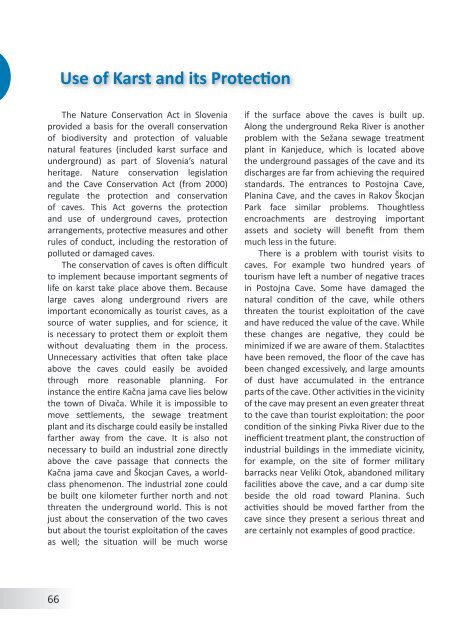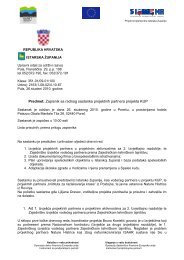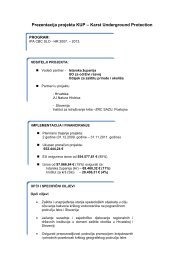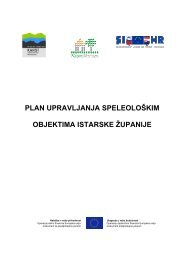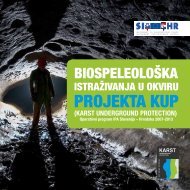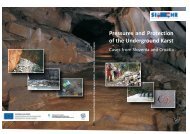Case Studies from the Dinaric Karst of Slovenia
Case Studies from the Dinaric Karst of Slovenia
Case Studies from the Dinaric Karst of Slovenia
Create successful ePaper yourself
Turn your PDF publications into a flip-book with our unique Google optimized e-Paper software.
Use <strong>of</strong> <strong>Karst</strong> and its ProtectionThe Nature Conservation Act in <strong>Slovenia</strong>provided a basis for <strong>the</strong> overall conservation<strong>of</strong> biodiversity and protection <strong>of</strong> valuablenatural features (included karst surface andunderground) as part <strong>of</strong> <strong>Slovenia</strong>’s naturalheritage. Nature conservation legislationand <strong>the</strong> Cave Conservation Act (<strong>from</strong> 2000)regulate <strong>the</strong> protection and conservation<strong>of</strong> caves. This Act governs <strong>the</strong> protectionand use <strong>of</strong> underground caves, protectionarrangements, protective measures and o<strong>the</strong>rrules <strong>of</strong> conduct, including <strong>the</strong> restoration <strong>of</strong>polluted or damaged caves.The conservation <strong>of</strong> caves is <strong>of</strong>ten difficultto implement because important segments <strong>of</strong>life on karst take place above <strong>the</strong>m. Becauselarge caves along underground rivers areimportant economically as tourist caves, as asource <strong>of</strong> water supplies, and for science, itis necessary to protect <strong>the</strong>m or exploit <strong>the</strong>mwithout devaluating <strong>the</strong>m in <strong>the</strong> process.Unnecessary activities that <strong>of</strong>ten take placeabove <strong>the</strong> caves could easily be avoidedthrough more reasonable planning. Forinstance <strong>the</strong> entire Kačna jama cave lies below<strong>the</strong> town <strong>of</strong> Divača. While it is impossible tomove settlements, <strong>the</strong> sewage treatmentplant and its discharge could easily be installedfar<strong>the</strong>r away <strong>from</strong> <strong>the</strong> cave. It is also notnecessary to build an industrial zone directlyabove <strong>the</strong> cave passage that connects <strong>the</strong>Kačna jama cave and Škocjan Caves, a worldclassphenomenon. The industrial zone couldbe built one kilometer fur<strong>the</strong>r north and notthreaten <strong>the</strong> underground world. This is notjust about <strong>the</strong> conservation <strong>of</strong> <strong>the</strong> two cavesbut about <strong>the</strong> tourist exploitation <strong>of</strong> <strong>the</strong> cavesas well; <strong>the</strong> situation will be much worseif <strong>the</strong> surface above <strong>the</strong> caves is built up.Along <strong>the</strong> underground Reka River is ano<strong>the</strong>rproblem with <strong>the</strong> Sežana sewage treatmentplant in Kanjeduce, which is located above<strong>the</strong> underground passages <strong>of</strong> <strong>the</strong> cave and itsdischarges are far <strong>from</strong> achieving <strong>the</strong> requiredstandards. The entrances to Postojna Cave,Planina Cave, and <strong>the</strong> caves in Rakov ŠkocjanPark face similar problems. Thoughtlessencroachments are destroying importantassets and society will benefit <strong>from</strong> <strong>the</strong>mmuch less in <strong>the</strong> future.There is a problem with tourist visits tocaves. For example two hundred years <strong>of</strong>tourism have left a number <strong>of</strong> negative tracesin Postojna Cave. Some have damaged <strong>the</strong>natural condition <strong>of</strong> <strong>the</strong> cave, while o<strong>the</strong>rsthreaten <strong>the</strong> tourist exploitation <strong>of</strong> <strong>the</strong> caveand have reduced <strong>the</strong> value <strong>of</strong> <strong>the</strong> cave. While<strong>the</strong>se changes are negative, <strong>the</strong>y could beminimized if we are aware <strong>of</strong> <strong>the</strong>m. Stalactiteshave been removed, <strong>the</strong> floor <strong>of</strong> <strong>the</strong> cave hasbeen changed excessively, and large amounts<strong>of</strong> dust have accumulated in <strong>the</strong> entranceparts <strong>of</strong> <strong>the</strong> cave. O<strong>the</strong>r activities in <strong>the</strong> vicinity<strong>of</strong> <strong>the</strong> cave may present an even greater threatto <strong>the</strong> cave than tourist exploitation: <strong>the</strong> poorcondition <strong>of</strong> <strong>the</strong> sinking Pivka River due to <strong>the</strong>inefficient treatment plant, <strong>the</strong> construction <strong>of</strong>industrial buildings in <strong>the</strong> immediate vicinity,for example, on <strong>the</strong> site <strong>of</strong> former militarybarracks near Veliki Otok, abandoned militaryfacilities above <strong>the</strong> cave, and a car dump sitebeside <strong>the</strong> old road toward Planina. Suchactivities should be moved far<strong>the</strong>r <strong>from</strong> <strong>the</strong>cave since <strong>the</strong>y present a serious threat andare certainly not examples <strong>of</strong> good practice.66


